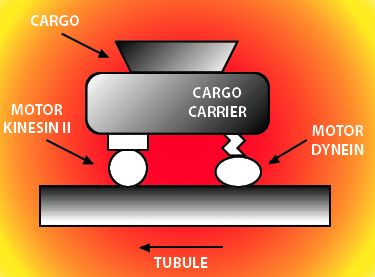Imagine that you had never seen a car or any automobile before. You might well be curious as to how the device is able to move. So you examine some vehicles in motion and you come to the obvious conclusion that the wheels are the agents of motion. This is all very obvious and all very true. However if you build a device with chassis and wheels only, you will not get very far. What a car requires is an engine manufactured in a factory and fuel to run the engine. Of course your car needs mechanics to maintain the engine too. It is immediately evident to you that the whole system is the result of designers who conceived of the whole idea and who specify how your car is to be manufactured and operated.
This reminds me of some tiny living cells which are able to propel themselves through a watery environment by means of a whip shaped thread called a flagellum. Many single celled algae move this way and even some which cluster in colonies. Also some single celled animals, and reproductive cells from some non-flowering green plants and from most animals.
Many years ago scientists (using microscopes) observed the beating flagella (plural of flagellum in Latin). Aha, they declared, the beating flagellum moves the cell. And this was true enough. This was like seeing a car proceed down the street.
Then in the late 1950s, they discovered that a flagellum consists of two very long tiny tubes (or tubules meaning tiny) enclosed by a circle of nine pairs of equally long tiny tubules, enclosed by another concentric circle, a protective membrane. The scientists were now at the stage you would be when you spotted that the car has wheels. They still had no idea how the whole thing moves.
Further fancy work with microscopes and biochemical studies revealed that the tiny tubes or tubules in the flagellum are joined by spokes. Some of the spokes, while anchored to one tubule, move up a nearby tubule. This causes the whole structure to bend. Other spokes prevent the whole apparatus from losing its shape when bending occurs. Eureka you say, the changing of position of the tiny tubes causes flexing of the flagellum and swimming of the cell! You have now discovered that the wheels of the car move. You haven’t really discovered why the wheels are able to turn.
Similarly scientists at this stage knew very little about the how or why of swimming microscopic cells. All that has changed within the past decade.
Lo and behold, what scientists have discovered is a transport system which shuttles all the needed components out to a flagellum construction site. The platform for the whole device is already present in the cell. This is called the basal body. Construction begins there and progresses outward. All new components are laid down at the outer tip.
 The cargo to build the tubules etc is moved by carrier cars which are equipped on the lower side with two different motors and on the upper side with equipment for holding on to the cargo. During growth of the flagellum, the cargo carriers zip along the outside wall of the already formed tubules. Their speed, at 2-4 microns per second, is truly astounding. The flagellum itself is only one quarter of a micron thick, but the flagellum may be several hundred microns long. While a micron is only a millionth of a metre, these distances are huge for the tiny machines involved.
The cargo to build the tubules etc is moved by carrier cars which are equipped on the lower side with two different motors and on the upper side with equipment for holding on to the cargo. During growth of the flagellum, the cargo carriers zip along the outside wall of the already formed tubules. Their speed, at 2-4 microns per second, is truly astounding. The flagellum itself is only one quarter of a micron thick, but the flagellum may be several hundred microns long. While a micron is only a millionth of a metre, these distances are huge for the tiny machines involved.
The whole system operates very smoothly. At the tip of the newly forming flagellum, the carriers release the building materials. These carriers now proceed downward along a different track. Once at the bottom, away they go again. This system continuously operates in a living flagellum.
Once the flagellum reaches its desired length, the cargo system serves to maintain it. In this case, quite a few empty cargo carriers zip outward, only to return with waste products. During the building phase, most cargo carriers are loaded moving outward and empty moving inward. When a flagellum is dismantled, most outward bound carriers are empty and most inbound ones are loaded.
This system of machines seems sophisticated even at first glance, but a study of the molecular details demonstrates how intricate the system really is. The cargo carriers are made up of 17 different components called proteins. In addition there are two motor proteins on the lower side.
During the outward journey a protein called kinesin II moves the cargo particle outward along the microtubule. If this motor protein is not present (possibly because of a mutation), then the cargo carriers do not move and no flagellum forms.
For the inward journey, the particles switch on a new motor protein called dynein (present on the outward journey, but not functioning). The dynein moves the cargo carriers back to home base.
Further studies have shown that other proteins are required to attach the motors to the carriers on the one side and also no doubt on the other side to link the cargo to the carriers, and to release it at the appropriate location. Once at the work site, the carriers which have just released their load, then become incapable of carrying cargo. This cargo-incapable status, (no doubt the result of a change in a protein), is important to ensure that the carriers do not mistakenly carry the building supplies back to home base!
A recent article on the astounding number of unique proteins in such a flagellum, drew my attention to this topic. The article was actually the cover story on the March 9, 2006 issue of Nature. Some scientists were studying a protozoan (single celled animal) called Trypansoma. This organism is notorious for causing a fatal sleeping sickness in people in Africa. Hence we see the reason for the interest in this particular creature.
The point of interest to us is the large number of proteins found in the trypanosome flagellum but not found in the cell proper. There are 331 such proteins found in the flagellum alone. While some proteins, like tubulin (making up the tubules) and kinetin and dynein, have similar forms in other motile cells, the majority (208) of these proteins are not found in any other group of organisms.
This unexpected finding caused scientists to compare the proteins in the trypanosome flagellum with those in two other well studied organisms. They found similar large numbers of unique proteins in the flagella of a green alga, and a protozoan related to the famous Paramecium as well.
The vast load of unique proteins was a huge surprise to these scientists. They had expected that the apparent similarity in overall design (supposedly indicating an evolutionary relationship) would be reflected in similar proteins making up the flagella. This is the kind of discovery which is driving some scientists almost to despair. If the flagellum were indeed the product of evolutionary processes involving time and chance, then the molecular components such as these proteins, should be similar rather than wildly different.
Thus just as you, in your capacity as industrial sleuth, would no doubt conclude that a car needs a highly designed and well maintained motor in order to move, so scientists have discovered that each flagellum is a highly complex system requiring a blueprint, with an assembly and maintenance system which includes motorized proteins fueled by the cell?s chemical energy supply. We may well guess that it is obvious to you, in your capacity as industrial sleuth, that a car nowhere develops spontaneously.
Similarly, in your capacity as observer of complex systems whether large or small, will you attribute the origin of the flagellum to spontaneous processes operating over millions of years, or to wise design? It seems almost too crazy to even ask that question except that many influential people refuse to choose the obvious answer. They haven?t looked at their own cars, have they?
Moxie
July 2006
Subscribe to Dialogue







